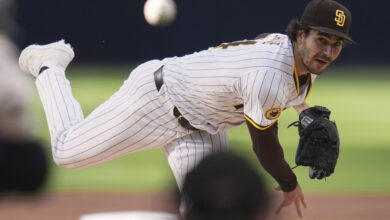
Cubs Look for Bargain with Former Red Sox RHP Marcus Walden
After two offseasons of bargain shopping for bullpen arms, the Cubs’ pitching infrastructure led by VP and director of pitching Craig Breslow has had its share of hits and misses. The hits include Andrew Chafin, Ryan Tepera, and Jeremy Jeffress, all of whom contributed a significant number of high-leverage innings before departing. Now they’re hoping they’ve found another diamond in the rough with 32-year-old righty Marcus Walden, who they just signed to a minor league deal.
Congrats to client @marcuswalden35 on agreeing to terms with the @Cubs. #Cubs #RedSox #MLB pic.twitter.com/cGXTSXyf5q
— Ball Players Agency (@BPA_Agency) August 19, 2021
Walden was a vital member of the 2019 Red Sox bullpen, producing solid if unspectacular results of a 3.81 ERA, 3.69 FIP, 53.5% groundball rate, 23.2% strikeout rate, and 9.8% walk rate over 78 innings. The shortened season was disastrous for the righthander, however, as each of those numbers either fell or rose precipitously over just 15 games. He has yet to appear in a major league game in 2021, but his Triple-A stats offer some optimism that he can regain that earlier form.
Prior to being released by the Red Sox earlier in the month, Walden posted a 4.01 ERA with a 4.49 FIP, 57.5% ground ball rate, 20.8% K rate, and a 9.9% BB rate over 42.2 innings. He was particularly good in July, allowing just two earned runs over 15.1 innings in seven appearances.
Not a flame-thrower by any stretch, Walden’s sinker averaged 92.7 mph in 2020. But what carried him in 2019 was his low-to-mid 80s slider. After throwing that slider for 37% of his pitches in 2019, however, he cut its usage almost in half in 2020 (22%) because he had apparently lost the feel for it. After limiting batters to a .191 BA and .307 slugging against the slider in 2019, it was tattooed for a .444 average with the same slugging last year. That made his other pitches worse and hitters looked like peak-era Barry Bonds against the sinker (1.273 SLG).
Walden’s slider was what helped him carve out a role as a 30-year-old rookie in 2019. He discussed the origin of his pitch development in an interview with David Laurila of FanGraphs, and you may notice a familiar name who had quite the career resurgence with the Cubs.
“I didn’t start pitching until my senior year of high school,” Walden said. “My freshman year [at Fresno City College] — the one year I went to school — I was throwing a four-seam fastball and a slider. Now I’ve gone back to that same style of a slider, although with a little bit different grip that I learned from Chandler Shepherd in 2017.
“And watching Craig Kimbrel was a big help. I watched him closely, especially in spring training of ’17 and ’18 when he was throwing his live BPs. I talked to him a little. It was, ‘All right. What kind of shape are we trying to make with this pitch?’ He throws a knuckle slider, and that’s what I throw now.”
Kimbrel throws what is classified as a knuckle-curve, but it is a power breaking ball regardless of how to classify it. He also experienced a disastrous season before making some tweaks with the help of the Cubs’ pitching infrastructure that restored him to his Hall of Fame form. It helps to throw in the upper 90s with the fastball and no one should expect a Kimbrel-esque performance out of Walden, but the Cubs have experience in reshaping spike-breaking pitches.
Armed with minor league options and room in both the Iowa and Chicago relief corps, the Cubs have plenty of runway to work with Walden. One consequence of trading the entire back half of their bullpen is that there are ample innings available to audition pitchers for future roles. It wouldn’t hurt to enter 2022 with yet another solid reliever.

